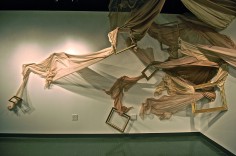CARLIE TROSCLAIR
source: featherofme
Carlie Trosclair is an installation artist from New Orleans. She received her BFA from Loyola University in 2008, earned an MFA from Washington University in 2010 and currently is a Community Arts Training Institute Fellow with the Regional Arts Commission. Carlie uses washed out tones, curvilinear geometry, draping fabric and textured transparency for creating sculptural installations and environments. Through the re-creation of existing spaces, her work aims to bridge the gap between the human body and the built environments which are so accepting that we may pass through them without particular notice or feeling of connectivity. “My installations explore our body’s relationship to the spaces we inhabit and encounter. By presenting new altered realities, I aim to engineer an experience focused on the visceral and sensorial elements of embodied perception,” says Carlie.
.
.
.
.
.
.
.
source: carlietrosclair
Based on these definitions dwelling will be defined as (1.) an intentional action of inhabiting and appropriating a physical interior space and (2.) an embodiment of a mental state of comfort and stability. Thus, undwelling can be defined as existing ‘outside’ or without physical and mental comfort within the context of the domestic. In a state of undwelling what was once habitable, concealed and attended to has become exposed, unlivable, and discarded. The palimpsest of paint, deteriorating structure, footprint of rust, or peeling back of wallpaper leave traces of additive efforts that now exist as subtractive re-formations of the desired functionality or intended use of the object/space. This shift from comfortable to uncomfortable, habitable to inhabitable disrupts both our physical and psychological relationships with a space or object. As a result, dwelling and undwelling coexist in a limbo of ‘(un)dwelling.’
.
.
.
.
.
.
.
.
source: riverfronttimes
Carlie Trosclair’s most recent installation was born amid bat shit and cobwebs. When the 26-year-old first laid eyes on the forsaken space that would become Kowalsky Intervention, she knew her days of working in tidy, sterile art galleries were at an end.
Trosclair would spend hours in those rooms — the abandoned second floor of an artist’s studio in Vermont where she completed a residency in June — scrubbing away mildew and battling mutant insects. She fell in love with the strata of decay and wanted to find a way to get people interested in the space again. In one room Trosclair sliced the antique wallpaper into rivulets that charted the cracks that erupted across the walls over decades of water damage and neglect. The space came alive, breathing through veins of floral screen-print and chipped paint.
The New Orleans native grew up wandering through empty, unfinished houses, as her father, an electrician, installed wiring for the families that would one day live there. Now she creates sweeping gestural landscapes out of fabric and other found material in the same sorts of spaces, years after the families have moved out and the wiring has come undone.
Carlie TrosclairRegina MartinezMallory NezamVisual ArtsArts, Entertainment, and Media
Increasingly she has come to understand her work through Freud’s concept of Das Unheimliche (“The Uncanny”): the cognitive dissonance that can morph the comforting and familiar into the strange and frightening. Or, as Trosclair describes it, “This weird push and pull that develops from the relationship between something that draws you in because of its familiarity but then retracts you because it’s also uncertain.”
Familiar but distant: In many ways the description applies to Trosclair herself. She’s affable and reserved — hesitant to use personal pronouns or discuss her private life, often speaking into the edges of space, as if her heart belongs to some other corner of the world.
In 2008, after majoring in fine arts at Loyola University New Orleans, Trosclair enrolled in the graduate program at Washington University’s Sam Fox School of Design & Visual Arts and soon found her focus shifting from painting to full-scale installations. Marrying familiar tokens of domestic life — vintage wallpaper, for example, or sheer chiffon — with disused spaces, her work began to challenge a viewer’s conditioned response to the built environment.
“We get accustomed to moving through doorways or walking into rooms a certain way. It becomes an action we don’t have any type of physical relationship to,” she says. “[I’m] thinking about how to reconstruct a space so that people think differently about how they move through it.”
Jessica Baran, a St. Louis-based poet who writes about visual arts for Riverfront Times, says it is the expanding scale of Trosclair’s installations, and her increasingly refined technique, that make her work so impressive.
“These ‘interventions’ are quasi-aggressive, but there’s such a thoughtfulness to her execution,” Baran says. “Her work is often disrupting the topography of a room entirely. But the disorientation that’s created isn’t sleight-of-hand or a bombastic experience. It’s contemplative.”
.
.
.
.
.
.
.
source: collectiftextile
Carlie Trosclair crée des installations atypiques avec la matière textile qu’elle impose dans l’espace.
Sortant d’un trou dans le mur ou figé dans des formes hybrides, le tissu utilisé par Carlie Trosclair semble toujours prendre vie et se transformer en une créature étrange indescriptible. En jouant sur les superpositions et les vieillissements des matières, le tissu paraît devenir un organisme vivant qui grouille dans nos vieilles maisons.


